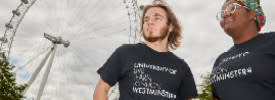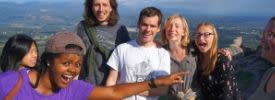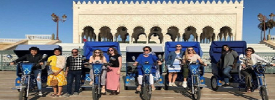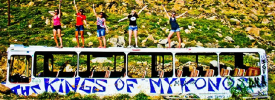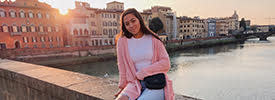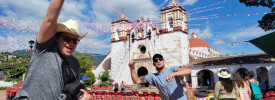Williamsburg: Time of My Life Past Review
By Andrea D (History, English, Trinity University) for
NIAHD Semester in-Residence at College of William & Mary
Yes. I gained self-confidence and friendships that really impacted my life. I am seriously considering returning to William & Mary for graduate school, or at least to Virginia for job prospects.
Review Your Program
|
* Overall educational experience
Academic rigor, intensity, resources, etc. |
Professors at William & Mary will work you, but they aren't completely mean about how they grade you. If you do the work, then you'll get good grades. You just have to be willing to put effort into what you do and pay attention in class, and most of all, participate. They don't want quiet students. |
|
* Host Country Program Administration
On-site administration of your program |
As mentioned before, students are limited to four classes, which only make a total of 12-14 hours. So if students are behind in credits, it's not ideal. However, the classes themselves make it worthwhile for going. Having field trip classes really opens students' eyes and gets them more interested in the history they're learning, as opposed to a powerpoint or book describing the places. William & Mary itself is a great campus for interaction, especially if you're a nerdy person. Within the first month, I'd joined two clubs--Science Fiction and Fantasy Club and the William and Mary Anime Society--and I felt like a W&M student myself. |
|
* Housing:
How satisfied were you with your living arrangements? |
Landrum Hall, where I lived during the semester, didn't have air conditioning. Virginia doesn't get hot, really, until about April. So having a fan would've been a good idea. But Jefferson, which I lived in during the summer, did. The only downside was having communal showers and bathrooms. |
| * Food: |
The Marketplace is the best place on-campus to eat. It has Chick-Fil-A and a really good Grille Works. The food is cheaper than at Sadler, where you pay $11 for a buffet that sucks. However, if you stay over the summer, Sadler is the only one open. Also, students can get a lot of food and sustenance from Wawa, the East coast equivalent of a 7-11, but with much better food selection and a cooking area that makes food fresh. |
|
* Social & Cultural Integration:
How integrated did you feel with the local culture? |
Everything at William & Mary, socially, is pretty awesome. Halls host ice cream socials and movie viewings throughout the semester and summer. Charter Day is very unique to them, because it celebrates the charter by King William and Queen Mary which founded the College. They have a formal that I didn't attend, but that seemed well-liked by students there. Then the clubs host multiple events that are quite enjoyable, like board games Saturday and dart guns Saturday night-Sunday morning. |
|
* Health Care:
How well were health issues addressed during the program? |
|
| * Safety: |
Williamsburg is a pretty quiet town. There's some crime, but nothing to suggest real fear for a person's life. Health is pretty big there, too. There weren't many outbreaks on-campus or anything. |
| If you could do it all over again would you choose the same program? |
Yes
|
Finances
|
* Money: How easily were you able to live on a student's budget?
(1 = not very easy/$200+ on food & personal expenses/week, 2.5 = $100/week, 5 = very easily/minimal cost) |
|
| Not including program expenses, about how much money did you spend on food and other expenses each week? | Because a meal plan isn't required at William and Mary, I spent anywhere from $50-$100 per week, depending on where and how much I decided to eat. |
| Do you have any general money-saving tips for future study abroad participants? | Sadler Center is really expensive if you don't have a meal plan. So if you stay over the summer, be prepared to cook or spend lots of money for bad food. |
Language
| How would you rate your language skills at the beginning of the program? | None |
Other Program Information
|
* Where did you live?
Select all that apply |
|
|
* Who did you live with?
Select all that apply |
|
|
* Who did you take classes with?
Select all that apply |
|
A Look Back
| * What do you know now that you wish you knew before going on this program? | Students who need credits, don't go. Students who don't and love history, go. |
Individual Course Reviews
| Course Name/Rating: |
Founding of Jamestown thru the American Revolution |
| Course Department: | HIST 216-02 |
| Instructor: | J.P. Whittenburg |
| Instruction Language: | English |
| Comments: | This is one of the classes that went from 8 to sometimes 7 p.m. once a week, on Fridays. You visited the relevant sites to history, then got to go to lunch, and then see more places. Readings are crucial in this class, because you hold discussions over lunch about the readings, relating them to the sites you visit. There is no midterm, just a final that tests you to make sure you did the readings throughout the semester and paid attention on the field trips. Dr. Whittenburg is a phenomenal teacher. |
| Credit Transfer Issues: | Not so far. |
| Course Name/Rating: |
The Era of Jamestown |
| Course Department: | HIST 491-06 |
| Instructor: | D. Brown |
| Instruction Language: | English |
| Comments: | This class was severely difficult because you started getting tired of Jamestown after awhile. Professor Brown was really engaging though, because he could relate to you. He is a Ph.D. student at William and Mary, getting his Ph.D. in anthropology. He teaches you about Jamestown from different angles--economics, material culture, anthropology and archaeology. You see Jamestown multiple times and other sites that relate to it. Readings are crucial in this class, too. You are tested at the end of the year with a 15-20 page paper on the topic of your choosing. This class also meets once a week, on Mondays. |
| Credit Transfer Issues: | Nope. |
| Course Name/Rating: |
History of Museums in the United States, from 1850-present |
| Course Department: | HIST 491-04 |
| Instructor: | S. Kern |
| Instruction Language: | English |
| Comments: | Dr. Kern is a hilarious, yet engaging professor. She used to work at Monticello, so anytime house museums are mentioned in the course, she has first-hand knowledge. The course itself is very challenging, in that most people never think about the history of museums or think that monuments and national parks count as museums, too. The class is discussion-based, with readings being key. Field trips don't occur as often in this class, but when they do, it gives students a new way of thinking about why we have museums and their relevance to present-day. There's a midterm, which consists of a powerpoint, describing the history of a place. The final does something similar, having students pick the top ten museums/national parks/monuments around the country, all connected by a theme. This class meets once a week, on Thursdays. |
| Credit Transfer Issues: | Nope. |
| Course Name/Rating: |
American Revolution thru American Civil War |
| Course Department: | HIST 216-01 |
| Instructor: | J.P. Whittenburg |
| Instruction Language: | English |
| Comments: | This class is similar to HIST 216-02. You meet once a week, on Wednesdays, and go on field trips around Virginia and the outlying states. Like HIST 216-02, you have lunch discussions of the readings and a final that tests your knowledge and understanding throughout the semester. You see Civil War battlefields, and it makes you rethink how you see the Civil War. |
| Credit Transfer Issues: | Nope. |

